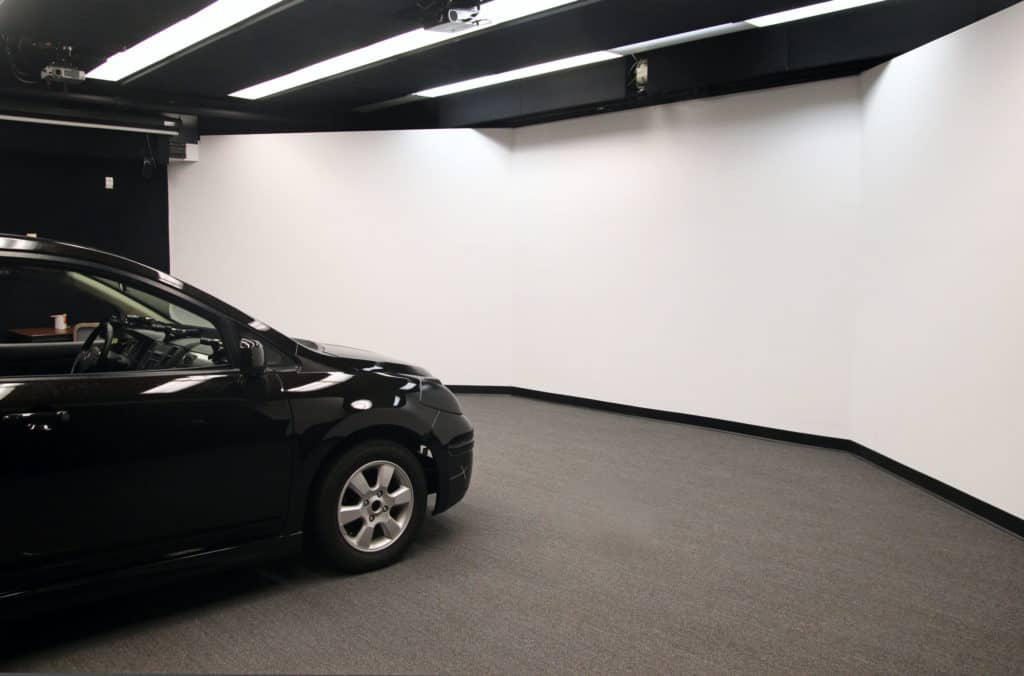Driving Simulator
Driving Simulator Lab
UMTRI’s fixed-base simulator consists of a Nissan Versa sedan located in a dedicated lab space, integrated with a simulation system running the latest version of Realtime Technology’s (RTI) simulation engine, SimCreator.
The simulator system incorporates a total of ten CPU units: a Host, which serves as the operator interface, six Image Generators, which render the various projected scenes, one CPU to render the virtual instrument cluster, one data-logging CPU, and one CPU to run the SmartEye eye-tracking system. Forward road scenes are projected on three screens about 16 feet in front of the driver (120-degree field of view) and a rear channel 12 feet away (40 degree field of view). Each forward channel is 1400×1050 and updates at 60 Hz. Optional lateral-view screens on the left and right of the simulator vehicle can provide an additional 80 degrees of visual view, for a total 200-degree field of view. The lateral screens and the rear channel are 1024×768.
Steering feedback is provided by a servo motor, and road vibration is delivered through a body-mounted shaker. The Versa’s original instrument cluster has been replaced by a virtual instrument cluster controlled by one of the simulation computers. Its interface can be custom designed to meet study demands using the industry standard development tool, Altia Design.
There are three separate audio systems:
- The fully functional production system on the Versa
- A cab interior system for issuing alerts, etc.
- A room system for simulating the external automotive audio environment

Eyetracking
A SmartEye four-camera eye-tracking system is installed in the cab of the Versa, and provides head-pose, eye-blink, and gaze data, which are fed to the Realtime simulation software. There, the gaze data are used to determine at which objects in the virtual world the subject looks. The simulator system includes a dedicated data-logging computer, which records objective measures from the Realtime simulation, synchronized with the eye-tracking data, and up to six channels of video and two channels of audio. UMTRI has developed analysis software which allows the overlay of the gaze vector onto the video of the forward scene.


Virtual worlds
Simulated worlds are created using tiles. The tile and object library includes urban, rural, suburban, and freeway environments and a wide variety of buildings, trees, and other objects. Weather (fog, rain, snow) can be simulated. Traffic is programmable, either using an “ambient traffic” model or with individually scripted vehicles. Pedestrians, bicycles, and other roadway users can also be incorporated into the world. The simulated driving environment is projected on five forward screens covering a 200-degree field of view, one rear screen, and two virtual side mirror displays. All production vehicle controls (e.g., turn signals, headlights, shifter) function and are interfaced to the simulator computers.


Desktop Driving Simulator
In addition to its fixed base driving simulator, UMTRI has a Desktop Driving Simulator which also runs RTI’s SimCreator. It consists of a host PC, 22’ LCD monitor, and high end gaming style steering wheel and pedals. The Desktop Driving Simulator is currently located in an office adjacent to the fixed base simulator lab. It is used for developing virtual worlds, testing, and research which benefits from a simpler, more compact system.
Data
Driver and vehicle objective data (steering wheel angle, speed, lane position, etc.) are recorded at up to 30 Hz by RTI’s SimObserver software. Video of driver actions (face, hands, and feet plus the instrument panel), and video from the road scene or other cameras (as needed to meet study requirements) are recorded by the same system. Up to six separate video sources can be synchronized to the objective data. The recorded video can incorporate text overlays of objective data. Two audio sources can also be recorded in synchronization with the objective data. Additional data can be included where studies require it – for example, the system was modified to record subject heart rate from a chest belt sensor.
Completed Research Projects
1. Bao, S. (2012). Internet Surfing and Texting While Driving: A Simulator Study of Teens and Adults. Sponsor: State Farm Mutual Automobile Insutrance Company.
2. Bingham, R. C. (2010-2011). Experimental Effects of Injunctive Norms on Simulated Risky Driving Among Teenage Males. Sponsor: Eunice Kennedy Shriver National Institute of Child Health & Human Development.
3. Bingham, R. C. (Ongoing). Experimental Research on the Effects of Positive Mood with High and Low Emotional Arousal on Teenage Driving Performance in the Presence of a Teenage Passenger. Sponsor: Eunice Kennedy Shriver National Institute of Child Health & Human Development.
4. Bingham, R. C. (2011-2012). Experimental Research on the Effects of Teenage Passengers on Teenage Driving performance. Sponsored by Eunice Kennedy Shriver National Institute of Child Health & Human Development. Sponsor: Eunice Kennedy Shriver National Institute of Child Health & Human Development.
5. Neitzel, R. L. (2012). Pilot evaluation of risk factors for adverse interactions between drivers and bicyclists. Sponsor: University of Michigan Injury Center.
Upcoming Research Projects
1. Bingham, R. C., Does Exclusion increase Risky Driving When Exposed to Risk-Accepting Passenger? Sponsor: Eunice Kennedy Shriver National Institute of Child Health & Human Development.
2. Pradhan, A. K., Risk-taking behaviors and pre-frontal cortex activity of male adolescents in the presence of peer passengers during simulated driving: A functional near-infrared spectroscopy (fNIRS) study. Sponsor: U.S. Department of Transportation.
3. Pradhan, A. K., Risk-taking behaviors and pre-frontal cortex activity of male adolescents with ADHD in the presence of peer passengers during simulated driving: A functional near-infrared spectroscopy (fNIRS) study. Sponsor: University of Michigan Center for Human growth and Development.
Contact
For more information about UMTRI’s driving simulator, please contact Dr. Anuj Pradhan (734-647-9191, anujkp@umich.edu).